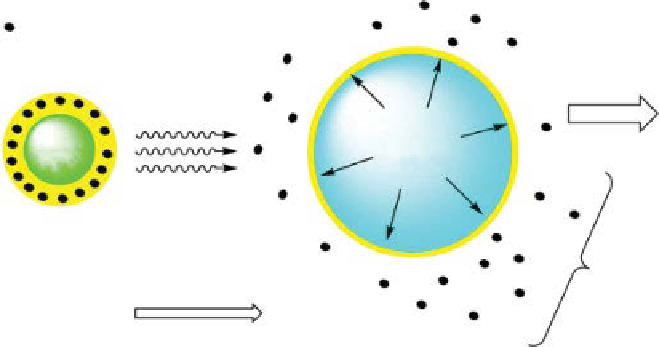Biomedical Engineering Reference
In-Depth Information
The bee venom-derived peptide melittin was incorporated into the lipid layer of the
pFC nanoemulsion [123], and it was shown that melittin pharmacokinetics and tumor
targeting were successfully achieved with dramatic tumor size reduction [124]. These
nanoemulsions also provided tumor-specific
19
F Mr images in the mouse model.
nanobees, therefore, represent a prime example of nanoemulsion theranostics.
rappaport
et al
. reported the delivery of pTX in a block-polymer-stabilized perfluo-
ropentane nanoemulsion guided by ultrasound and Mri in a mouse tumor model
[121]. in this formulation, the low-molecular-weight and low-boiling-point pFC
perfluoropentane was used to promote ultrasound-triggered drug release. in this
example, pFC is fulfilling two distinct roles, a dual-mode imaging agent (ultrasound
and Mr) and a drug release-controlling agent. Therefore, pFCs are again demonstrated
to be very versatile materials for theranostic development. Beyond imaging, pFC
nanodroplets can be used for controlled release using ultrasound [121, 125]. The
ultrasound-responsive nanoemulsions are prepared with low-boiling-point pFCs,
perfluorohexane and dodecafluoropentane (DDFp). rappaport
et al
. describe DDFp
nanoemulsions that grow from nanosized droplets to microbubbles under the effect
of ultrasound [126]. This droplet increase in size can provide echogenic signal and
at the same time induce drug release, as described in Figure 15.6.
nanoemulsions are stabilized by a relatively low amount of surfactant. They can be
stabilized by both ionic and nonionic surfactants. low droplet size of nanoemulsions
(150-200 nm) facilitates passive targeting to tumors and easy penetration to inflamed
tissues via epr effect. passive targeting to circulating inflammatory cells by pFC
nanoemulsions has been extensively investigated for the purpose of
19
F Mri of
inflammation [119, 127-129] and potentially drug delivery to inflamed tissues [3]. a
recent study used pFC nanoemulsions to deliver antigen to dendritic cells with the
goal of boosting the immune response in DC-based vaccines [130]. For active targeting
Drug
Ultrasound
Image
PFC
liquid
PFC
gaseous
Drug release
Nanoemulsion
(150-300 nm)
Microbubble
figure 15.6
pFC nanoemulsion with drug loaded in the hydrophobic core of the surfactant
layer when exposed to ultrasound expands in size as pFC shifts from liquid to gaseous phase.
This change triggers the drug release and provides ultrasound imaging contrast.

Search WWH ::

Custom Search